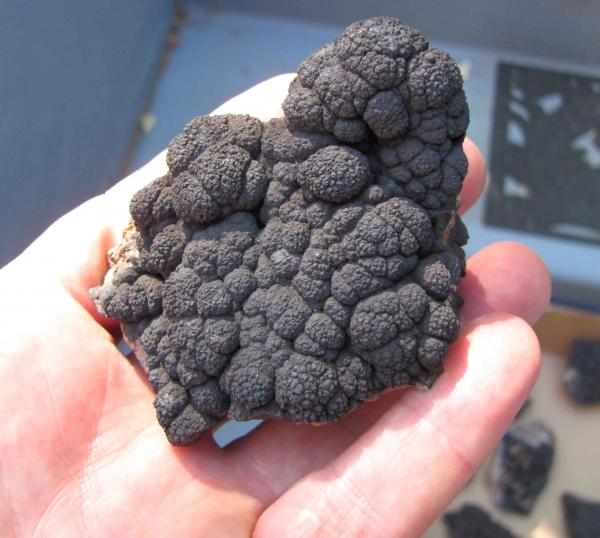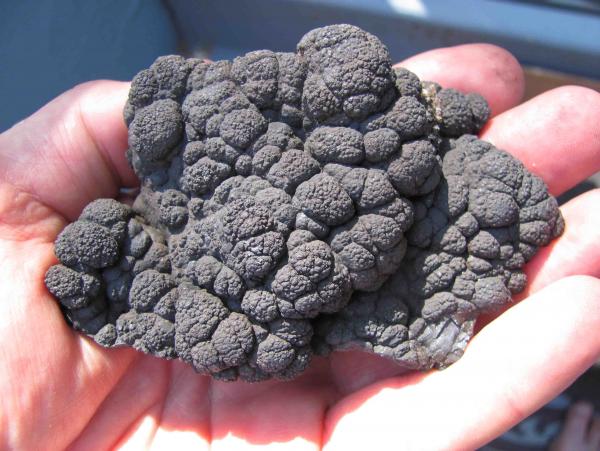| View previous topic :: View next topic |
| Author |
Message |
bugrock

Joined: 24 Nov 2008
Posts: 137
Location: Michigan


|
 Posted: Jun 11, 2010 19:13 Post subject: Groutite Identification Posted: Jun 11, 2010 19:13 Post subject: Groutite Identification |
|
|
I am wondering if there is a reliable physical method short of formal analysis to distinguishing groutite from the more common manganese minerals manganite and pyrolusite. All three vary in habit.
If the question is manganite vs pyrolusite the different color of streak seems to work (brown vs dark gray/blank) but it appears the color of the streak for groutite varies and may overlap the colors seen with the other two minerals.
As groutite is less common and specimens often have a higher price tag it would be very useful to be confident of identity.
Thanks for your help.
|
|
| Back to top |
|
 |
Peter Megaw
Site Admin

Joined: 13 Jan 2007
Posts: 975
Location: Tucson, Arizona



|
 Posted: Jun 11, 2010 19:25 Post subject: Re: Groutite Identification Posted: Jun 11, 2010 19:25 Post subject: Re: Groutite Identification |
|
|
This is a tough call...mostly because few care that much about manganese oxides...historically soft Mn-ox got called pyrolusite and hard Mn-ox got called psilomelane. Having worked extensively with Mn-oxides I gave up on visual identification unless very well crystallized and stuck to XRD. I have been pleasantly surprised by recent interest in some Mn-ox species, like the recent romanechites from Chihuahua. it took Raman to ID it though...
| Description: |
| Romanechite...Chihuahua City, Mexico |
|
| Viewed: |
20826 Time(s) |

|
| Description: |
|
| Viewed: |
20832 Time(s) |

|
_________________
Siempre Adelante! |
|
| Back to top |
|
 |
bugrock

Joined: 24 Nov 2008
Posts: 137
Location: Michigan


|
 Posted: Jun 11, 2010 20:04 Post subject: Re: Groutite Identification Posted: Jun 11, 2010 20:04 Post subject: Re: Groutite Identification |
|
|
Peter,
Thanks. Have been told the 'psilomelane" minerals are particularly difficult in that you need both elemental analysis and a spectrum to pin a name on them.
George
|
|
| Back to top |
|
 |
Montanpark

Joined: 06 Nov 2008
Posts: 241
Location: Mainz



|
 Posted: Jun 12, 2010 06:21 Post subject: Re: Groutite Identification Posted: Jun 12, 2010 06:21 Post subject: Re: Groutite Identification |
|
|
George,
Peter has made a very valid point. An example of my experience: since i have got quite a lot of specimens a few years ago from the collection of the late Paul Hanses from the Bülten-Adenstedt mine, THE locality for Groutite and Ramsdellite in good specimens in Germany (and maybe Europe) i was very pleased (but also quite puzzled) seeing the all black and lustrous crystallized (but with quite differing habit) manganese oxides from there in the lot. So i decided to do an XRD on all visually different specimens (with one example for each "habit group") and was surprised that all gave groutite patterns. Some also had manganite and very few ramsdellite matches so intergrowth and pseudomorphs are possible (and well known from there). Of course i can not guarantee that ALL of the approx 50 specimens are groutite but i have a good probability from the exemplary XRD analyses. Visually i would say it is very hard to determine but the "classic" groutite habit from this mine is very characteristic. For any other mine from where i do not know the specimens from own experience i wouldn´t be able to visually identify groutite without doubt so any phase analysis would be necessary.
Regarding the "psilomelane" stuff .. no chance without chemical and other analytical methods to nail down exactly.
cheers
Roger
|
|
| Back to top |
|
 |
Luiz Menezes
Joined: 10 Dec 2009
Posts: 140
Location: Belo Horizonte


|
 Posted: Jun 12, 2010 20:13 Post subject: Re: Groutite Identification Posted: Jun 12, 2010 20:13 Post subject: Re: Groutite Identification |
|
|
Inside cavities in granitic pegmatites the most common form of manganese oxyde is cryptomelane; for me it is impossible to guess without a qualitative chemical analysis, done through micro-probe, that will detect the presence of K, and further X-ray diffraction has confirmed that it is cryptomelane; some few times K cannot be detected, and then the X-ray normally shows that the mineral is pyrolusite; it is totally impossible to identify them just by the habit.
Luiz
|
|
| Back to top |
|
 |
bugrock

Joined: 24 Nov 2008
Posts: 137
Location: Michigan


|
 Posted: Nov 05, 2010 18:44 Post subject: Polianite and manganese oxides Posted: Nov 05, 2010 18:44 Post subject: Polianite and manganese oxides |
|
|
From what I can gather the term polianite is used as a variety of pyrolusite psm manganite. Based on previous comments it takes formal analysis to pin down the troublesome manganese oxide species.
On going through examples on mindat there are many instances where pyrolusite and ramsdellite form 'blocky' crystal groups. These two minerals are distinct species and apparently only distinguished on analysis. Wonder how often these names are used correctly.
But another puzzle is polianite. If this is a psm after manganite and the transition is chemically complete how would one know it is a psuedomorph even on analysis, assuming the 'blocky' crystal shape can be seen in both pyrolusite and manganite?
Like other variety names suppose 'polianite' could inappropriately be applied to what have always been pyrolusite crystals with blocky habit or needles tightly arranged in a 'blocky' form only because such material differs from the more typical needle like habit of pyrolusite.
George
|
|
| Back to top |
|
 |
Jordi Fabre
Overall coordinator of the Forum

Joined: 07 Aug 2006
Posts: 5102
Location: Barcelona



|
 Posted: Nov 06, 2010 11:33 Post subject: Re: Polianite and manganese oxides Posted: Nov 06, 2010 11:33 Post subject: Re: Polianite and manganese oxides |
|
|
I believe in Europe "Polianite" is used for blocky crystals of Pirolusite instead needles and not for the pseudos, but as you mention this question it could be interesting to know that most (if not all) "Manganites" from the famous classic german locality of Ilfeld, in fact are not pure Manganite, but Manganite after Pyrolusite crystals.
On the other hand, the acute crystals of "Manganite" from Wessels and N'Chwaning mines them are really pure Manganite and not pseudos.
|
|
| Back to top |
|
 |
Tom Tucker
Joined: 03 Dec 2009
Posts: 60
Location: Virginia


|
 Posted: Nov 07, 2010 10:30 Post subject: Re: Groutite Identification Posted: Nov 07, 2010 10:30 Post subject: Re: Groutite Identification |
|
|
Jordi, I've had this exact same question concerning the manganite-pyrolusite crystals from the various abandoned mines in Fort Valley, Virginia. They are sharp, lustrous black crystals but are they manganite or pyrolusite, or a pseudomorph of one after the other, and in that case, how would you know?
I'm running in to a similar problem in West Texas - I have confirmed nice micro-clusters of cryptomelane crystals, but there are also larger, black and brown blocky, well formed crystals in a variety of shapes that mostly appear to be pseudomorphs. I suppose I can have the present substance identified, but will we ever know what the precusors were ?
Tom
|
|
| Back to top |
|
 |
Jordi Fabre
Overall coordinator of the Forum

Joined: 07 Aug 2006
Posts: 5102
Location: Barcelona



|
 Posted: Nov 07, 2010 11:05 Post subject: Re: Groutite Identification Posted: Nov 07, 2010 11:05 Post subject: Re: Groutite Identification |
|
|
| Tom Tucker wrote: | | but are they manganite or pyrolusite, or a pseudomorph of one after the other, and in that case, how would you know?... |
By EDS or RDX, analizing the core and the surface of the crystals.
Jordi
|
|
| Back to top |
|
 |
bugrock

Joined: 24 Nov 2008
Posts: 137
Location: Michigan


|
 Posted: Nov 09, 2010 21:50 Post subject: Re: Groutite Identification Posted: Nov 09, 2010 21:50 Post subject: Re: Groutite Identification |
|
|
If material is pure and if you are sure the material is either pyrolusite or manganite the streak of pyrolusite is dark grey-black and that of manganite brownish. But there are too many 'ifs' should little be known about the locality. There are other manganese oxide and Mn-O-Ba etc species as discussed under this thread previously. Also Fe-O species likely to occur in the same locations. Others not mentioned here can be found on mindat etc.
I've been shown the best way to check streak is to pick off a bit of mineral (metal picks like dental tools or those similar tools sold in hardware stores/ work with magnification) and crush it well in a white or very light colored mortar and pestle. The color will then be obvious, only very tiny fragments are needed, and you do not have to fear chipping or scratching your specimen.
But back to the term polianite, I wonder if it could be overused non-specific term, like adularia.
George
|
|
| Back to top |
|
 |
bugrock

Joined: 24 Nov 2008
Posts: 137
Location: Michigan


|
 Posted: May 11, 2011 00:13 Post subject: Re: A Dark Topic and a "Pearl" Posted: May 11, 2011 00:13 Post subject: Re: A Dark Topic and a "Pearl" |
|
|
Hello all,
Returning to an old thread, the dark manganese oxides/hydroxides with the hope some will want to read more on the subject?
A paper was presented at the last Rochester Symposium and the following article cited.
It is not too difficult to wade through and explains basic structures and significance for mineralogy and materials science.
Give it a try. I am not a mineralogist but this is the clearest presentation of the subject I've run across.
And yes, the 'pearl". I became aware at the symposium that mineralogy and materials science are not always on a four (OK eight) lane highway into each others realms even thought that seems logical. I know there are exceptions and some are very comfortable in both fields. If not overly technical this feels like a thread for future discussion.
George
Citation:
Proc. Natl. Acad. Sci. USA
Vol. 96, pp. 3447–3454, March 1999 Colloquium Paper
This paper was presented at the National Academy of Sciences colloquium ‘‘Geology, Mineralogy, and Human Welfare,’’ held November 8–9, 1998 at the Arnold and Mabel Beckman Center in Irvine, CA.
Manganese oxide minerals: Crystal structures and economic and environmental significance
JEFFREY E. POST Department of Mineral Sciences, Smithsonian Institution, Washington, DC 20560-0119
|
|
| Back to top |
|
 |
|




